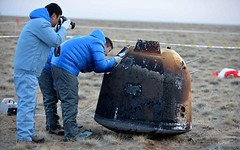the October 24 launch of the Long March 3C rocket carrying Chang'e-5 T1 to the Moon before putting an official name to the engineering test.
Part of this mission is still underway, though many who are interested outside China's official circles believed the awkwardly named composite mission came to an end when the Xiaofei ("Little Flyer") sample return and high-speed reentry test article arrived back on Earth, November 1.
 |
| Xiaofei is recovered after its eight day journey around the Moon [Xinhua]. |
The China National Space Administration (CNSA) reports the service module of China's "unmanned test lunar orbiter entered a 127-minute orbit on Tuesday, after three orbital transfers since Sunday."
Using backup equipment from the Chang'e-3 together with test articles ahead of the Chang'e-5 sample return mission scheduled for 2017, the CNSA announced it had skipped over the "Chang'e-4" designation, originally a name for a back-up mission if Chang'e-3 had failed, and named the present intermediate test "Chang'e-5 T1."
Based on released schematics and photographs of both Chang'e-3 and Chang'e-5 T1 vehicles while each was being prepared for launch, the "T1" service module now in lunar orbit does not resemble the earlier orbital science platforms Chang'e-1 or 2. It more likely resembles the now-familiar profile of the Chang'e-3 lander, without the legs.
"To decelerate the craft enough for entering its target orbit," CNSA reported, "the service module conducted three braking maneuvers on Sunday, Monday and Tuesday.
"After the circular orbit stabilizes," the T1 service module will continue in polar orbit, at an altitude of 200 km, "for tests to validate key technologies for the next lunar probe mission, Chang'e-5."
"The spacecraft has enough power remaining and is in sound condition," according to CNSA.
"Technicians on Earth have exercised timely and stable control, with the tasks of tracing the service module and system tests progressing well."
Chang'e-5 T1 was launched on October 24, 2014, and "the service module was separated from the orbiter's Xiaofei return capsule, with the capsule returning to Earth after circling behind the moon during an eight-day mission.
"The service module reached the Earth-Moon second Lagrange Point (L2) in late November and left L2 point January 4, after completing all preset scientific tasks," CNSA reports.
"The orbiter is a test run for the final chapter of China's three step lunar program -- orbiting, landing and returning," CNSA announced. "The obtained data and validated re-entry technology will be used for the development of Chang'e-5, which is slated for launch around 2017.
Related Posts:
Chang'e-3 lander still operational on 1st year anniversary (December 16, 2014)
China celebrates successful “Xiaofei” (November 2, 2014)
China launches lunar sample return test mission (October 23, 2014)
Chang'e-3 lander and rover from LRO (March 4, 2014)
Chang'e-3 and Yutu survive first lunar night (January 14, 2014)
China's Jade Rabbit, it's time in the Sun (December 15, 2013)
Jade Rabbit successfully deployed to the lunar surface (December 14, 2013)
It's not bragging if you do it (December 9, 2013)
"Lunar Aspirations" - Beijing Review (December 9, 2013)
Chang'e-3 safely inserted into lunar orbit (December 6, 2013)
Chang'e-3 and LADEE: The Role of Serendipity (October 31, 2013)
Outstanding animation celebrates China's Chang'e-3 (October 29, 2013)
China's grand plan for lunar exploration (October 11, 2012)
ILOA to study deep space from Chang'e-3 (September 11, 2012)
China's Long March to the Moon (January 14, 2012)
China plans lunar research base (May 11, 2011)
Chang'e-2 arrives in mission orbit (October 9, 2010)
Chang'e-2 takes direct approach (October 1, 2010)
Chang'e-2 sets stage for future lunar missions (September 3, 2010)
Chang'e-1 research reported published (July 22, 2010)


No comments:
Post a Comment